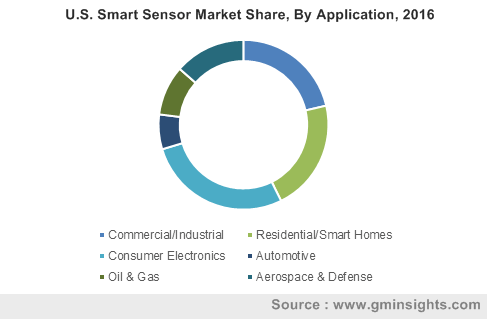Smart sensors market revenue to quadruple by 2024, high demand from residential applications to spur the industry growth
Publisher : Fractovia | Published Date : 2017-05-19Request Sample
The world is trending toward the adoption of smart technologies for a comfortable & connected lifestyle, pertaining to which Smart sensors market will grow lucratively over the years ahead. Emerging developments in the smart technology industry such as smart homes and smart cities will also influence Smart sensors industry size significantly. The governments of various countries have been encouraging the deployment of smart technologies across their respective countries to promote an enhanced standard of living. Moreover, heavy investment by the industry giants in the development of connected technologies will impact positively on product demand. As per the report by Global Market Insights, Inc., “Smart sensors Market having had a revenue of USD 20 billion in 2015, will register an annual growth rate of more than 17% over the coming seven years.”
Speaking of the technological outlook, MEMS technology segment will record an annual growth rate of more than 15% over the period of 2016 to 2024. Surging adoption of the Internet of Things coupled with the implementation of smart technologies in wearable electronics such as smartwatches will augment the Smart sensors industry growth considerably. In the automotive sector, this technology is increasingly used in airbags subject to strict government rules and regulations regarding passenger safety.
U.S. Smart Sensor Market Share, By Application, 2016

Automotive application segment of Smart sensors market will collect significant revenue over the years ahead, owing to the installation of sensor based systems. The automotive sector is gaining prominence across APAC, subject to which Asia Pacific Smart sensors market will generate lucrative revenue over the coming timeframe, subject to the usage of Smart sensorss in connected cars. India, Japan, and China will be the major revenue contributors. Shifting consumer trends toward the adoption of wireless technology along with increasing awareness regarding energy conservation will fuel the product demand. Additionally, manufacturers are implementing this technology to increase their production capacity and to maintain top business position.
The key participants in Smart sensors market includes Analog Devices, Eaton Corporation, General Electric, ABB Group, Emerson Electric, Atmel Corporation, InvenSense, NXP Semiconductors, Honeywell, Robert Bosch, Infineon Technologies, Legrand S.A., Sensirion, and TE Connectivity, and Smart sensors, Inc.
North America Smart sensors industry will record substantial growth rate over the coming seven years. U.S. will be the major contributor of North America market share, owing to the changing preferences for smart homes. Sensors being highly eco-friendly, are used to monitor the pollutant content in the environment. Chemical sensors are primarily used for this purpose. They are also used in the aerospace and defense applications, owing to which Smart sensors market from aerospace and defense applications is slated to witness significant growth potential over the coming years of 2016 to 2024. The attributing factor toward the industry growth is the introduction of new technologies in the sector.
Residential applications will stimulate Smart sensors market, due to implementation of energy management and home security systems in residential complexes. Position sensors, touch sensors, image sensors are the notable products used by the customers. Image sensors are mainly installed in residential areas to monitor visitors, which will help to reduce theft activities. Escalating demand for smart phones and tables, which are enabled with touch sensors, will also favorably boost Smart sensors market share.
Surging adoption of wireless networks across the commercial sector is anticipated to generate lucrative avenue for the manufacturers. Wireless network segment of Smart sensors industry will register significant CAGR over the period of 2016 to 2024, owing to the considerable product demand subject to its cost effectiveness and high speed.
To strengthen the current customer base, renowned market players are adopting growth strategies to fulfill consumer demands. These companies are also actively engaging in strategic collaborations and partnerships to sustain the market position.